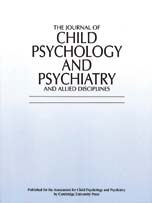Crossref Citations
This article has been cited by the following publications. This list is generated based on data provided by
Crossref.
Happé, Francesca
1999.
Autism: cognitive deficit or cognitive style?.
Trends in Cognitive Sciences,
Vol. 3,
Issue. 6,
p.
216.
Mottron, L.
Peretz, I.
Belleville, S.
and
Rouleau, N.
1999.
Absolute pitch in autism: A case study.
Neurocase,
Vol. 5,
Issue. 6,
p.
485.
Mercier, Céline
Mottron, Laurent
and
Belleville, Sylvie
2000.
A Psychosocial Study on Restricted Interests in High Functioning Persons with Pervasive Developmental Disorders.
Autism,
Vol. 4,
Issue. 4,
p.
406.
Gillet, Patrice
2001.
Autisme et psychomotricité.
p.
113.
Procter, Harry G.
2001.
PERSONAL CONSTRUCT PSYCHOLOGY AND AUTISM.
Journal of Constructivist Psychology,
Vol. 14,
Issue. 2,
p.
107.
Pelphrey, Kevin A.
Sasson, Noah J.
Reznick, J. Steven
Paul, Gregory
Goldman, Barbara D.
and
Piven, Joseph
2002.
Visual Scanning of Faces in Autism.
Journal of Autism and Developmental Disorders,
Vol. 32,
Issue. 4,
p.
249.
Mottron, Laurent
Burack, Jacob A.
Iarocci, Grace
Belleville, Sylvie
and
Enns, James T.
2003.
Locally oriented perception with intact global processing among adolescents with high‐functioning autism: evidence from multiple paradigms.
Journal of Child Psychology and Psychiatry,
Vol. 44,
Issue. 6,
p.
904.
Frith, U.
Hill, E. L.
Booth, Rhonda
Charlton, Rebecca
Hughes, Claire
and
Happé, Francesca
2003.
Disentangling weak coherence and executive dysfunction: planning drawing in autism and attention–deficit/hyperactivity disorder.
Philosophical Transactions of the Royal Society of London. Series B: Biological Sciences,
Vol. 358,
Issue. 1430,
p.
387.
Mann, Tania A.
and
Walker, Peter
2003.
Autism and a deficit in broadening the spread of visual attention.
Journal of Child Psychology and Psychiatry,
Vol. 44,
Issue. 2,
p.
274.
Mitchell, Peter
and
Ropar, Danielle
2004.
Visuo‐spatial abilities in autism: A review.
Infant and Child Development,
Vol. 13,
Issue. 3,
p.
185.
Brosnan, Mark J.
Scott, Fiona J.
Fox, Simone
and
Pye, Jackie
2004.
Gestalt processing in autism: failure to process perceptual relationships and the implications for contextual understanding.
Journal of Child Psychology and Psychiatry,
Vol. 45,
Issue. 3,
p.
459.
Mottron, Laurent
2004.
L'autisme : une autre intelligence.
p.
207.
Deruelle, Christine
Rondan, Cecilie
Gepner, Bruno
and
Tardif, Carole
2004.
Spatial Frequency and Face Processing in Children with Autism and Asperger Syndrome.
Journal of Autism and Developmental Disorders,
Vol. 34,
Issue. 2,
p.
199.
Gagnon, Louise
Mottron, Laurent
Bherer, Louis
and
Joanette, Yves
2004.
Quantification Judgement in High Functioning Autism: Superior or Different?.
Journal of Autism and Developmental Disorders,
Vol. 34,
Issue. 6,
p.
679.
Hadjikhani, Nouchine
Chabris, Christopher F.
Joseph, Robert M.
Clark, Jill
McGrath, Lauren
Aharon, Itzhak
Feczko, Eric
Tager-Flusberg, Helen
and
Harris, Gordon J.
2004.
Early visual cortex organization in autism: an fMRI study.
NeuroReport,
Vol. 15,
Issue. 2,
p.
267.
Bertone, Armando
Mottron, Laurent
Jelenic, Patricia
and
Faubert, Jocelyn
2005.
Enhanced and diminished visuo-spatial information processing in autism depends on stimulus complexity.
Brain,
Vol. 128,
Issue. 10,
p.
2430.
Pellicano, Elizabeth
Maybery, Murray
and
Durkin, Kevin
2005.
Central coherence in typically developing preschoolers: does it cohere and does it relate to mindreading and executive control?.
Journal of Child Psychology and Psychiatry,
Vol. 46,
Issue. 5,
p.
533.
Happé, Francesca
2005.
Handbook of Autism and Pervasive Developmental Disorders.
p.
640.
Chapman, Peter
Ropar, Danielle
Mitchell, Peter
and
Ackroyd, Katie
2005.
Understanding boundary extension: Normalization and extension errors in picture memory among adults and boys with and without Asperger's syndrome.
Visual Cognition,
Vol. 12,
Issue. 7,
p.
1265.
Noens, Ilse L.J.
and
Berckelaer-Onnes, Ina A. van
2005.
Captured by details: sense-making, language and communication in autism.
Journal of Communication Disorders,
Vol. 38,
Issue. 2,
p.
123.

